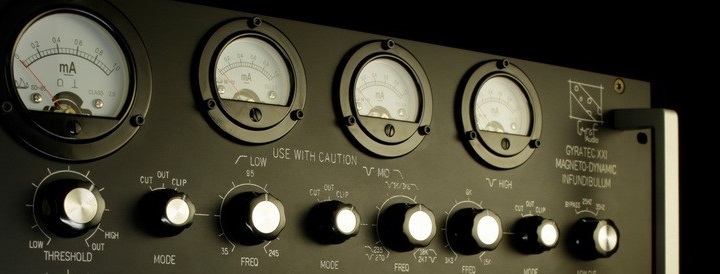Interview with Jakob Erland from Gyraf Audio
Jakob Erland, founder of Gyraf Audio (Denmark), talks about the developement of his Gyratec XXI Magneto-Dynamic Infundibulum
.
Q: Hello Jakob, could you please shortly introduce yourself to the readers.
.
I’m Jakob Erland – the developer, solderer, engraver, marketing, packing and maintenance guy at Gyraf Audio. I’m 48, a Psychologist of profession, and currently part-time working in Aarhus University, teaching statistics to poor unfortunate psychology students. Apart from Audio, my main interest is in psychological angles on artificial intelligence, where I’m working on a phd thesis (slowly).
.
My background in Audio comes from being into electronics since a young age, combined with working as a sound engineer in Danish studio “Feedback Recording” for a couple of decades. Being among the most influential Danish studios in 80’es and early 90’es, we had some VERY talented sound engineers who naturally got most of the gigs, so I moved more and more into servicing the huge collection of gear for the lack of having anything better to do. Note that at that time, massive amounts of analogue gear was mandatory in a real studio, and maintenance was massive and continous.. Over time, my interest shifted from keeping alive the classics, into designing something new and needed, and in that process I had tremendous help in being in an environment made up of golden ears. All the Gyraf products have been (and is) developed through numerous iterations of design, user test, redesign, user test, tweaking etc. – until a certain point where users are happy (i.e. they won’t let go of the unit for further tweaking), at which time we “freeze” the design at that iteration.
.
Then at some point, visiting engineers started to ask for a take-out version of the units we had developed for in-house use, at which time Gyraf Audio was born. This was sometime around ’94.
.
.
Q: Today we are talking about your newest product, the „Gyraf Audio Gyratec XXI Magneto-Dynamic Infundibulum. I think it´s very special. Could you explain in a few sentences what it is and how the unit works?
.
Aah – the G21, yes. It is damn hard to describe. Here’s a short background resumé:
.
It actually started out as a joke – I and two engineer friends were at an animated Christmas party and started rambling about what the limits of passive dynamics control would be… Was like: “We have these passive-technology EQ’s, that has these subjective qualities we like, why not move passives into dynamics also, by making an extended-control analogue clipper?” We agreed that clipping as a phenomenon is underrated and most often wrongly used (or used for the wrong reasons..) and that passive clipping (like the Prismsound overkiller) actually is a pretty nice thing if it can be kept under tight control. Control is the key word here – the overkillers feels too primitive to be of any real creative use (no offense ment to Prism, it was just the consensus at the time).
.
We continued to joke about functions and controls that would be nice to have on such an imaginary passive clipper, and when we got to multi-band dynamics control we laughed a lot about having a set of parallel analogue transmission lines (for circumventing the classic problem of phase when band-splitting and recombining) and then clipping at the far end of those filters, which would prevent the distortion products from re-entering the audio (because if you have e.g. a 1khz bandpass, and content around that is clipped, the resulting harmonics will be 2, 3, and 4khz etc. – which will have a hard time escaping through the 1khz transmission line back into the audio). Actually very funny at the time, there was consensus that there is no free lunch like that in analogue audio, although none of us entirely understood why in this case.
.
But then the idea kinda haunted me for a while, and I felt stuped because I couldn’t REALLY grasp why it wouldn’t work. So a year or so later I ended up building a quick mock-up of the unit – and much to my surprise (and a bit of chock, I admit) the principle actually worked in some roundabout way. The most strange thing about it is probably why no one had done this before – the Old Men were certainly not stupid, and the needed parts has been common since early 40’es.
.
At the first many prototypes, the G21 was codenamed AudioShaver – because I saw it’s main function as loudness optimizing. But my main test pilot Emil Thomsen insisted that the effect would be very interesting as a dynamic EQ and sound shaper as well – and the unit developed quite a lot in this direction. The name Magneto-Dynamic Infundibulum comes from A) that we do the clipping by loading down (shorting) an audio transformer, thus more or less in magnetic domain, and B) the “Infundibulum” comes from the fact that we passively funnel audio through to the clipper stages, giving the distortion products a hard time escaping. The funnel also describes a nice but strange side-effect: When band-clipping at areas where there is “hair” or short-duration level peaks due to phase relationships rather than actual perceived levels, the effect is that the unit first tries to “push” the phase of the signal in question, only to start real clipping if pushing phase through ±90 degrees still does not get it under threshold. Viewed on a ‘scope, it kinda looks like the peaks go down into a funnel…
.
Now you may want to ask: “What happens to the left over distortion products in the filter?” Simple answer is: We use them to drive the meter movements.
.
When going through the various prototypes of the unit (The final G21 is somewhere around 33’th iteration of the idea), we realized how different a tool we had at hand – it can have the nonlinear dynamics that we most often associate with magnetic tape, but at the same time there are so many ways to shape and control it’s parameters that it doesn’t end there. And yes, we think of control-ability as a paramount parameter – but this does not mean that the function is entirely predictable. There is a very complex mess of interacting nonlinearities going on – and it’s almost impossible to predict exactly which setting would suit a particular mix or sound. At least, we haven’t had it long enough to know it that well – the unit exhibits a chaotic behaviour in the basic sense of this concept; not random at all, but following a controlled set of “strange” attractors that is under user control, if not entirely under user prediction. This is the reason for the “USE WITH CAUTION” engraved on the front panel. There is no set-and-forget with this unit.
.
Maybe the best way to think of the G21 (as dynamics control) is to see it as a tool that can act on and control transients that are buried “inside” or “below the surface” of a mix, without messing with time constants. And as a coloring tool, i think of it as a dynamic EQ that is entirely out-of-circuit and transparent whenever signal content is below-threshold. This off course for the frequency-selective bands, as the overall clipper is much more self-explanatory and easier to conceptualize.
.
.
Q: The unit has a passive design. Can you tell us the advantages of the passive design?
.
Yes, the G21 is entirely passive – no power consumption, no power connector. This is not because of the original joke of passiveness (we’re not THAT weird), but because we found that this could offer us a very gentle gradual control over the process: (following snip from our website) In essence, we want complete control and predictability in the clipping process – and we want to preserve signal integrity as far as possible. In passive domain, we are more or less restricted to what could be described as ‘first order’ non-linearities – we do not convolute clipping on top of clipping (i.e. distortion on the distortion products) like it would most often happen in an active circuit under feedback control. It’s hard enough to navigate the chaotic processes already – we do not want to add unnecessarily to the mess (/snip). The main drawback in being full-passive is the stupid amounts of parts matching that is essential for getting the unit behaving nice as a tracking stereo device. We’ve had some experience in this area already, building the G14 EQ, otherwize I’m not sure we’d have the guts for taking up a stereo version.
.
And also: It’s passive because it’s possible.
.
[*The name Magneto-Dynamic Infundibulum is also a paraphrase over Kurt Vonnegut’s Chrono-Synclastic Infundibulum – but I’m not sure we need to go there]
.
.
Q: Thank you Jakob for this interview!
.
.
.
.
.
The Gyratec XXI and all our other Gyraf Audio products you can find here.




Schreibe einen Kommentar
Du musst angemeldet sein, um einen Kommentar abzugeben.